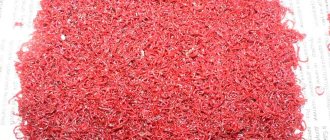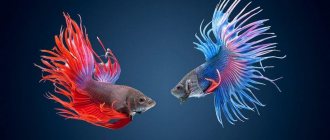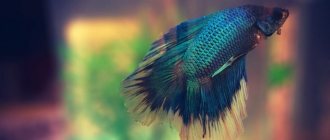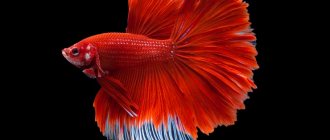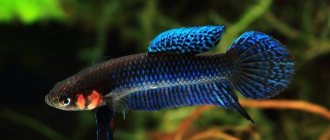Cockerel
Cockerel, Betta fish or Siamese cockerel are the names of a popular fish with a fighting character native to Thailand, Malaysia, and the islands of Indonesia. Breeders have developed species of betta fish that adequately represent breeders at international ornamental fish competitions. In addition to their bright appearance, cockerels attract experienced aquarists and beginners due to their unpretentious maintenance and care.
Description
A variant of this fish in nature is the Siamese betta. It has a long body, short round fins, and body color varies from brown to greenish. In aquariums you can find a huge number of different species and hybrids. In their creation, the main parameter was no longer legendary aggressiveness, but external attractiveness.
But in their homeland in Thailand, it is still a real fighting fish. Although fighting in cities is officially prohibited, it is still carried out in villages and underground. But aquarium species are more peaceful than wild ones.
Betta fish have a huge number of different options for fins, colors and other parameters. The length of the individual reaches approximately 6-7 cm in length.
How long do betta fish live? Life expectancy is not very high and even with good care, they usually do not live more than 3 years.
All types of cockerels have approximately the same sexual differences. Males are larger, and the color of their body and fins is brighter. But females are not only paler in color, but also much smaller, and they also have a rounded abdomen.
Origin of the betta fish
The appearance of the first mentions of these fish can be dated back to 1800, since it was during this period that the attention of the local residents of Siam (modern Thailand) was attracted by small fish that showed aggression towards each other. Individuals of the “brawlers” were distinguished by short fins and a not particularly attractive dark body color. For some time, the inhabitants of Siam crossed wild “fighters” and eventually got a new species called “biting fish” (Pla Kat).
These fighting fish were assigned to the genus Macropodus in his manuscripts by the naturalist and part-time Danish physician T. Cantor, after he was given several unique and especially valuable specimens of betta fish by the King of Siam in 1840. And in 1909, the world famous ichthyologist C. Tate gave this species a new name Betta splendens.
The first fighting fish arrived in Paris in 1892, and in Germany four years later. Fourteen years later, in 1910, the Siamese cockerel was able to appear in the United States of America, thanks to F. Locke from San Francisco (California). During the selection, he was able to develop a new color color, previously not inherent in this species.
The appearance of betta in Russia is associated with several versions. According to one of them, the famous aquarist of the 19th century, V. Desnitsky, back in 1896, brought exotic species of plants and fish from Singapore, but there is no confirmation anywhere that there were cockerels among them.
According to another version, at approximately the same time period, amateur aquarist V. Melnikov carried out the process of breeding the first labyrinth fish in Russia, and in honor of this discoverer, much later, a competition was formed to present the best betta fish.
According to the third version, betta fish came to Russian territory with the help of the Frenchman G. Seyselem, and from the offspring of these fish, representatives of not only Russian, but also European betta fish appeared.
The Council of Ministers of Thailand on February 5, 2021 was able to confirm that their national aquatic animal is the Siamese fighting fish.
Varieties
There are a huge number of varieties and hybrids of bettas. They can all be conditionally divided into several groups using a certain classification parameter.
Based on the shape of the fins and their size, the following types are distinguished:
- veiled cockerel;
- crown-tailed cockerel;
- two-tailed;
- racemetails;
- flagtails;
- posters;
- royal (aka giant);
- deltatails;
- crescent-tailed (half-moon cockerel);
- round-tailed.
Another existing classification is based on the color of the scales on the fish:
- monochrome;
- two-color;
- multicolor.
As for colors, the most popular colors are blue and white. For example, it is the latter shade that is used to color Half Moon, which is often found in aquariums. But according to many, the most beautiful variety, veil, is found in both blue and red.
Maintenance and care
Those who see such fish in small jars in pet stores often think that their maintenance and care are quite simple. In general, this is true, but they still need some space. The cockerel also lives in a mini tank of 15-20 liters, but 30 is still better. Although this is common, keeping it in a round aquarium is not recommended; such fish experience stress in it. Also, the container must be closed, otherwise the aquarium betta fish can easily jump out.
It will be quite problematic to keep someone other than a male. During the spawning period, it is very aggressive and can even attack its own female. If you decide to start breeding, you will need a large aquarium for your betta, with various hiding places. The female will hide in them from the male.
Once a week you need to change a quarter of the water. Aeration is not required as the betta will rise to the surface to breathe. But the filter will be useful.
The most important water parameter is temperature. Bettas are a tropical species, so the aquarium should be warm - from 24 to 29 degrees. Other parameters: pH: 5.0-8.0, dGH 5-35.
A few hours a day of natural sunlight is desirable. It is better to avoid a large amount of vegetation in the aquarium. Since aquarium bettas can damage their beautiful fins on it. Also, make sure that there are areas on the surface that are not occupied by flora - the fish will come up to breathe.
In general, caring for this type of fish is not difficult. Therefore, it is perfect for beginners who want to buy a small aquarium with a cockerel and one fish.
Feeding
Now let's figure out what to feed the betta fish. This species is not picky about food. Able to eat live and frozen food, as well as industrial and dry food. True, some individuals may still refuse the latter, so carefully monitor when feeding takes place.
Cockerels especially love bloodworms, especially large ones. Also, don’t mind eating small aquarium snails, if there are any in the container. And large ones, like ampullaria, can bite off the whiskers, but usually they are no longer capable of killing adults.
Who do they get along with?
Although the aquarium betta fish is not as aggressive as its wild relative, it almost cannot get along with other inhabitants of the aquarium. First of all, there should be only one male in the container, otherwise they will definitely fight with each other. But there may be several females; they are very friendly with each other.
As for other fish with which the betta fish gets along, small characins, barbs and viviparous fish are suitable. But avoid introducing large individuals. In a large aquarium, a domestic betta usually does not attack other fish.
Diseases
Before getting a fish, you first need to learn better about diseases and their treatment. Most often, diseases of this type of fish manifest themselves through changes in their behavior. They become lethargic and little mobile. They often sit at the bottom of the aquarium.
Other signs of health problems include clenched fins, a position on its side, or a position where the betta is lying on the bottom and breathing heavily. The color may also fade, white threads extending from the body, spots on the scales.
All diseases of cockerels can be divided into three groups:
- parasitic;
- bacterial;
- fungal.
Ichthyophthyriosis is one of the most common diseases. It is also called betta decoy and is caused by the protozoan Ichthyophthirius multifiliis. The disease manifests itself in compression of the fins, abnormal behavior with jerky swimming and the desire to itch everything in the aquarium. For treatment, preparations containing copper are used.
Oodinosis. This disease manifests itself primarily in golden spots on the body and the habit of lying on the bottom. Without treatment, the fish may die. You need to use products such as Formamed, Oodinol and others containing copper.
Fin rot is a bacterial disease. It is a consequence of improper maintenance and low temperatures. The fins acquire a whitish tint and gradually decompose. For treatment you can use Bicillin-5, Biseptol-480.
Habitat
In nature, these fish live in Thailand and the neighboring countries of Southeast Asia. Another name - Siamese cockerel or hen - comes from the former name of Thailand, Siam. It was here, in their homeland, that they first noticed the grumpy nature of cockerels and fought with the handsome ones. With the popularization of the aquarium business, the fame of the betta fish spread throughout the world. Today, instead of fights, there are peculiar “beauty contests”. Exhibitions are completely peaceful in nature; only external characteristics are assessed at them: size, color, compliance with standards.
Reproduction
Puberty occurs in males at 3–4 months. But for reproduction it is better to use a pair about 6 months old. An interesting feature is that males that breed regularly have enlarged fins. Females, if they do not spawn for a long time, lose this ability due to blockage of the genital opening.
It would be best to use separate spawning tanks if you intend to breed bettas. A small aquarium, about 5 liters, is perfect. The height of the water should reach 10-15 cm. Soil is not needed as such, but you need to plant more plants. The female will hide in them from the male, and he will build a nest.
The temperature should be higher than in a regular aquarium - about 30 degrees. Use fresh water and feed the fish with live food. First, place the male in the container. He will build a nest of air bubbles held together by saliva. Then plant the female.
Spawning usually occurs after about a few days. If he is not observed for more than a week, try changing the female. But it also happens that the male is simply too aggressive - then he will have to be replaced.
After the bettas have finished breeding, remove the female from the aquarium. The male will remain inside and take care of the eggs. He will remove the unfertilized eggs himself. If necessary, feed with bloodworms, only well-washed ones. Up to 400 eggs are usually laid during one spawning.
Fry
After about 1.5-2 days, larvae will appear from the eggs. And after 4-6 days, they will begin to swim around the aquarium. At this time, remove the male from the spawning area, as he will try to return the larvae to the nest and may crush them.
The labyrinthine organ, which allows breathing air from the surface, appears in fry only at several months. Therefore, the spawning tank will require aeration. If this is not available, you can try lowering the water level.
At first, feed the fry “live dust”. Also, ciliates are suitable. If they are unavailable, you can use the yolk of hard-boiled chicken eggs. But this is still not advisable.
When the fry have grown a little, you can use newborn brine shrimp larvae to feed them. Subsequently, choose food depending on the size of the fry. You can also use chopped tubifex or special industrial food for fry.
Loading …
Behavior
The cockerel sometimes shows contact towards people and allows itself to be stroked. You should not do this too often, since, firstly, the human body temperature is higher than the water temperature, and the touch can be felt by the fish as a burn. Secondly, you can damage the protective layer of mucus on the surface of the body, without which resistance to bacterial infections decreases. Thirdly, immersing dirty or just washed hands with soap in a small reservoir of water inevitably leads to disruption of the biosystem: a sharp increase in the level of alkali or the introduction of infections. The smaller the volume of the aquarium, the greater the chance of “spoiling the water” in it.
Sometimes inexperienced owners can watch in horror as the fish lies on the bottom and does not move. There is no need to worry, since this is how the betta sleeps. After a short rest, the fish will definitely return to its favorite place: closer to the surface of the water.
The aggression of fish knows no bounds: males can fight to the point of exhaustion even with their own reflection in the mirror. They do not tolerate any neighbors, even those of their own kind. Based on this grumpiness, fish fights were held. Now such dubious entertainment events are prohibited almost everywhere.
Photo gallery
Photo 1. Fry two days after spawning
Photo 2. Fry at 1 month
Photo 3. Frozen bloodworms
